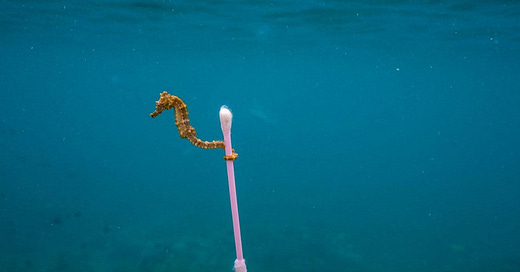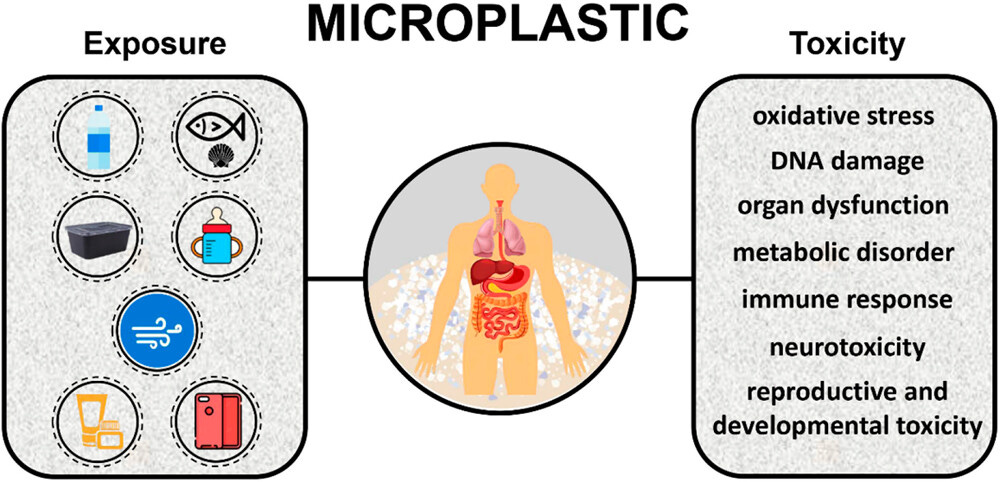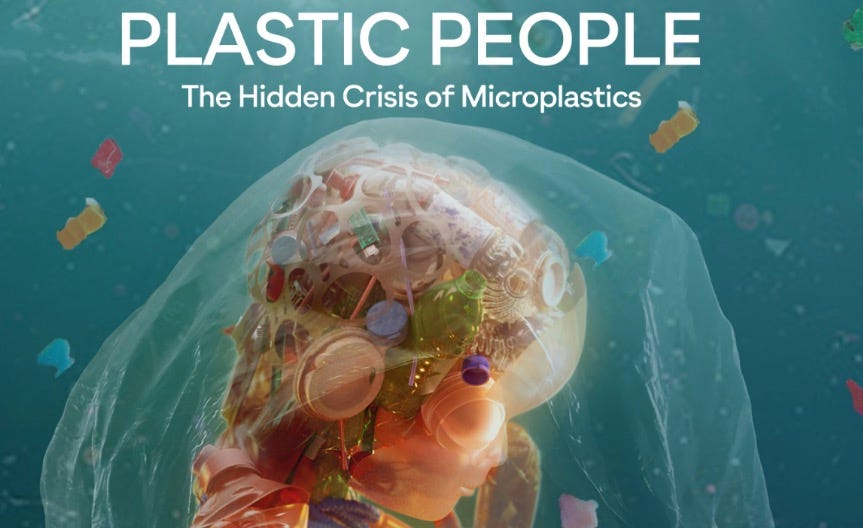Becoming Plastic People on a Plastic Planet
Plastic pollution linked to increases in inflammatory bowel disease, cancers, obesity, infertility and heart disease
Each of us could be ingesting as much as a credit-card-sized amount (5 grams) of microplastics every week, according to a 2021 study in the Journal of Hazardous Materials.
Micro- and nanoplastic particles (MNPs) have been found in the air we breathe, the water we drink, and the food we eat. Consider:
43 trillion miniature-plastic particles rain down on Switzerland every year.
the average liter of commercially-available bottled water has nearly a quarter million pieces of MNPs, according to a new study.
Babies fed using plastic baby bottles swallow millions of particles a day, according to a 2020 study.
MNPs have been found throughout the body including blood, kidneys, bladder, liver, and even in the brain. Recently researchers found MNPs in every human placenta they studied.
Need-to-Know: We make 450 million tons of plastic a year
Several billion tons of plastics contaminate our planet’s soil, water, and air, according to scientific estimates. At least 450 million tons of new plastic is produced every year and tens of millions of tons end up in the environment every year. Over time plastics break down into ever smaller bits eventually becoming micro- and nanoplastic particles.
8 Need-to-Knows:
99% of plastics are made from fossil fuels.
90% of the petrochemical industry production is for making plastics
Plastics are made from more than 10,000 different chemicals, most have never been tested for safety. At least 4,200 are considered hazardous.
Some chemicals in plastics are known endocrine-disrupting chemicals, which can interfere with the body’s natural hormones.
Plastic products, such as food packaging, can contain hundreds of different chemicals, many of which are hazardous.
Plastics leach chemicals, particularly when heated.
MNPs not only leach chemicals, but they can also act like magnets for bacteria and other toxins.
MNPs also act like tiny pieces of grit damaging delicate cell membranes, causing inflammation or riling up our immune systems.
The health impacts of all this plastic in our bodies have been difficult to determine. But that is changing quickly. Scientists and medical health experts now say MNP pollution is a serious threat to human health and well-being.
Need-to-Know: Plastics linked to increases in many diseases
A growing number of studies link microplastics to increased inflammatory bowel disease and cancers in people under 50, as well as diabetes, reproductive disorders, neurological impairments in children, obesity, and heart disease.
For example, our exposure to endocrine-disrupting chemicals in plastics is a prime suspect in the startling decline in male fertility around the world with a more than 50% drop in sperm counts over the last 50 years. This decline has increased dramatically since the early 2000s as plastic production ramped up and plastic products became commonplace everywhere.
Need-to-Know: Chemicals in plastics added $250 billion in health care costs annually
Endocrine-disrupting chemicals in plastics cost the U.S. an estimated $250 billion in increased healthcare costs a year, according to a 2024 study
MNPs in the plaque lining the walls of arteries increased the risk of a heart attack or death nearly five-fold in patients being monitored for heart conditions.
Need-to-Know: Can the Global Plastic Treaty save us?
A legally-binding UN Global Plastic Treaty intends to cap the amount of new plastic being made and control the toxic chemicals being used. Countries with large fossil fuel and petrochemical sectors, such as the U.S., China, and Saudi Arabia oppose these measures.
The treaty is in final negotiations in Ottawa at the end of April (INC-4) and Busan, Korea at the end of November (INC-5).
Need-to-Know: Only loud voices will produce a strong plastics treaty
It’s a good idea to make your concerns about plastics and the serious impacts on our health—not to mention our environment— known to your national government.
Need-to-Know: How to reduce the plastic pollution you’re consuming.
It’s not easy. A few thoughts:
Avoid food and drink in plastic containers or packaging.
Filter your water using granular activated charcoal or reverse osmosis filtration. (We boil our water, let it cool, and filter it with a paper coffee filter. Surprising how clear it looked and tasted better.)
Avoid single-use plastic take-out containers.
Some of you will have other ideas and tips. Do share them in the comments below.
Until next time, be well.
Stephen
PS: An important new film coming out soon: Plastic People: The Hidden Crisis of Microplastics. Here’s a review in Variety magazine.
Don’t know where you can see the film yet so keep an eye out for it.








